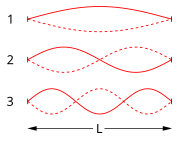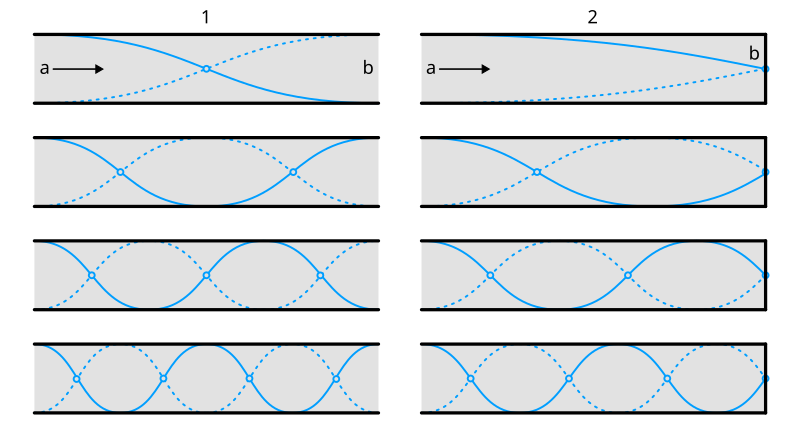OCR Specification focus:
‘Produce stationary waves with microwaves, stretched strings, and air columns.’
Stationary waves, also known as standing waves, form when two progressive waves of the same frequency and amplitude travel in opposite directions and interfere. They play a crucial role in understanding resonance, musical instruments, and wave behaviour in confined systems.
The Concept of Stationary Waves
When two identical waves moving in opposite directions overlap, their superposition creates regions of no displacement (nodes) and regions of maximum displacement (antinodes). The pattern formed appears to “stand still”, hence the name stationary wave.
Stationary Wave: A wave pattern formed by the superposition of two identical progressive waves travelling in opposite directions, producing nodes and antinodes at fixed positions.
Unlike progressive waves, stationary waves do not transfer energy along the medium. Instead, energy oscillates locally between kinetic and potential forms.
Conditions for Forming Stationary Waves
Stationary waves form under specific conditions:
Two waves must have the same frequency, wavelength, and amplitude.
The waves must travel in opposite directions along the same line.
Reflection at a boundary is usually required to produce the counter-propagating wave.
The medium must support resonance, such as a string or an air column fixed at certain points.
When these conditions are met, constructive and destructive interference create the stationary wave pattern.
Stationary Waves on Stretched Strings
A stretched string fixed at both ends provides a classic example of stationary waves. When the string is plucked or driven by a vibration source, reflections at the fixed ends cause the incident and reflected waves to interfere.
At each fixed end, displacement must be zero, forming a node.

A labelled diagram of the first three standing-wave modes on a string of length L, fixed at both ends. Nodes occur at the ends (and evenly spaced along the string at higher modes), while antinodes mark maximum displacement. This directly illustrates how reflection and superposition create a stationary pattern on strings. Source.
Between nodes, the displacement varies, creating antinodes where oscillation amplitude is maximum.
The simplest mode of vibration is the fundamental mode or first harmonic, where there is one antinode between two nodes. Higher harmonics occur when additional nodes and antinodes form along the string.
EQUATION
—-----------------------------------------------------------------
Wave Speed (v) = fλ
v = wave speed (m s⁻¹)
f = frequency (Hz)
λ = wavelength (m)
—-----------------------------------------------------------------
For a string of length L, the fundamental wavelength is twice the string length (λ = 2L). Higher harmonics have wavelengths λ = 2L/n, where n is the harmonic number (1, 2, 3, …).
The frequency depends on the tension (T) and mass per unit length (μ) of the string:
EQUATION
—-----------------------------------------------------------------
Frequency of vibration (f) = (1/2L) × √(T/μ)
L = length of vibrating string (m)
T = tension in the string (N)
μ = mass per unit length (kg m⁻¹)
—-----------------------------------------------------------------
This relationship shows that higher tension or lower mass per unit length increases the frequency, producing higher-pitched tones.
Stationary Waves in Air Columns
Air columns within tubes can also support stationary waves when driven by sound sources such as tuning forks or loudspeakers. The wave reflects at the ends of the tube, creating interference between incident and reflected sound waves.
Two primary types of air columns exist:
Open tubes: Both ends open to the air.
Closed tubes: One end closed, one end open.
In open tubes, antinodes form at both open ends, since the air is free to move, while nodes occur within the tube.

A comparative diagram of standing waves in open and closed tubes, showing fixed node/antinode conditions at the ends. The patterns illustrate why the fundamental in an open tube has λ = 2L, while a closed tube’s fundamental has λ = 4L. Extra detail: higher harmonics are shown for clarity, which slightly exceeds the immediate syllabus focus. Source.
For an open tube of length L, the fundamental mode corresponds to half a wavelength fitting into the tube (λ = 2L). For a closed tube, the fundamental mode fits a quarter wavelength (λ = 4L).
Higher harmonics occur when additional nodes and antinodes fit within the same tube length, following predictable ratios of wavelength and frequency.
Stationary Waves with Microwaves
Stationary waves can also be formed using microwaves in laboratory experiments. A microwave transmitter emits waves towards a reflecting metal plate. The incident and reflected waves interfere to form a stationary pattern of nodes and antinodes.
A microwave detector probe can move through the field to detect points of maximum and minimum intensity:
Antinodes correspond to points of maximum signal (constructive interference).
Nodes correspond to points of zero signal (destructive interference).
The distance between adjacent nodes is half the wavelength (λ/2) of the microwaves.
This experimental method allows accurate measurement of microwave wavelengths.
Understanding Nodes and Antinodes
Node: A point in a stationary wave where the displacement of the medium is always zero.
Antinode: A point in a stationary wave where the displacement of the medium reaches its maximum amplitude.
The fixed spacing between nodes and antinodes represents half the wavelength, a key characteristic of stationary waves across different systems.
Energy Distribution in Stationary Waves
In a stationary wave, energy is not transmitted through the medium as in a progressive wave. Instead, the energy oscillates between kinetic and potential forms within each segment:
At nodes, potential energy is maximum and kinetic energy is zero.
At antinodes, kinetic energy is maximum and potential energy is zero.
This energy exchange repeats rhythmically without net energy flow across the medium.
Experimental Production of Stationary Waves
To produce stationary waves, the following steps can be used for each medium:
Stretched String
Attach one end of the string to a vibration generator.
Adjust the frequency of the signal until resonance occurs and a stationary pattern forms.
Observe nodes and antinodes along the string.
Air Column
Use a tube with one or both ends open.
Drive sound waves into the tube using a tuning fork or loudspeaker.
Adjust the frequency or length of the column to locate resonance positions.
Microwaves
Direct microwaves toward a metal reflector.
Move a receiver along the path to detect alternating maxima and minima of intensity.
Determine the wavelength using the spacing between nodes.
Stationary waves thus represent a fundamental principle of wave physics, providing the basis for resonance phenomena in strings, air columns, and electromagnetic systems. Their formation through superposition and reflection demonstrates the deep connection between wave behaviour, frequency, and boundary conditions.
FAQ
The amplitude of a stationary wave depends on the amplitude of the original progressive waves and the degree of resonance achieved.
At resonance, the driving frequency matches a natural frequency of the system, and energy is transferred most efficiently, leading to maximum amplitude at the antinodes.
If the frequency is slightly off resonance, the amplitude decreases significantly because the wave patterns no longer reinforce perfectly.
In a stationary wave, energy oscillates locally between kinetic and potential forms rather than travelling through the medium.
Each point vibrates around its equilibrium position without causing a net flow of energy to adjacent points.
This occurs because the forward and backward progressive waves carry equal energy in opposite directions, resulting in complete cancellation of energy transfer along the medium.
Tension changes the wave speed, which directly affects the frequency of the harmonics that can form.
Increasing tension increases wave speed, producing higher frequencies for the same string length.
Decreasing tension reduces wave speed, resulting in lower frequencies.
The relationship between these quantities is given by v = √(T/μ), showing that wave speed increases with the square root of tension.
Only certain frequencies cause resonance because the air column must fit an exact number of half or quarter wavelengths within its length.
If the frequency is not one of these resonant values, the reflections from the ends interfere destructively, preventing a stable standing pattern from forming.
The permitted frequencies correspond to harmonics or overtones that satisfy the boundary conditions of the tube (open or closed ends).
Several factors influence precision when detecting microwave nodes and antinodes:
Detector positioning: The probe must move smoothly along the beam path without tilting or changing orientation.
Reflector alignment: The metal plate must be perpendicular to the beam for consistent reflection.
Environmental interference: Reflections from walls or objects can distort the intensity pattern.
Measurement precision: The node spacing (λ/2) should be measured carefully with minimal parallax error.
Careful setup ensures accurate determination of wavelength and consistent node–antinode detection.
Practice Questions
Question 1 (2 marks)
A stationary wave is formed on a stretched string fixed at both ends. Explain what is meant by a stationary wave and describe how nodes and antinodes are formed.
Mark scheme:
1 mark: States that a stationary wave is formed by the superposition of two identical progressive waves travelling in opposite directions.
1 mark: Explains that nodes occur where destructive interference causes zero displacement, and antinodes occur where constructive interference causes maximum displacement.
Question 2 (5 marks)
A student investigates stationary waves on a stretched string using a vibration generator. The string is 1.2 m long and fixed at both ends. The student observes that the first three harmonic patterns can be produced.
(a) Draw labelled diagrams of the first three harmonics, showing the positions of nodes and antinodes. (3 marks)
(b) Explain how the frequency of vibration changes between the first and third harmonics. (2 marks)
Mark scheme:
(a)
1 mark: Correctly shows the first harmonic with one antinode between two nodes (λ = 2L).
1 mark: Correctly shows the second harmonic with two antinodes and three nodes (λ = L).
1 mark: Correctly shows the third harmonic with three antinodes and four nodes (λ = 2L/3).
(b)
1 mark: States that the frequency increases with harmonic number (f ∝ n).
1 mark: Explains that the frequency doubles for the second harmonic and triples for the third because f = nv/2L, where n is the harmonic number and v is constant for the string.

